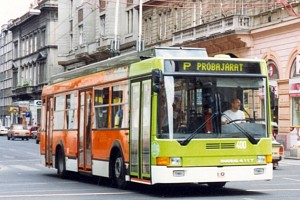 József Kisl
|
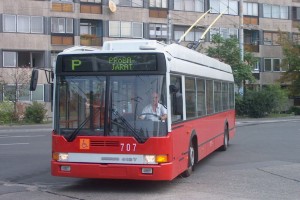 |
|
Right: Trolleybus 707 at Örs vezér tere, once again as a trial run. |
|
|
|
Low-floor Ikarus trolleybuses |
|
 József Kisl
|
 |
|
Right: Trolleybus 707 at Örs vezér tere, once again as a trial run. |
|
The appearence of the low-floor vehicles in the '90s has dramatically changed the autobus-market. Due to the new regulations and the new "fashion" trend, every major bus-producer started to develop its new low-floor construction. As the market of trolleybuses is much smaller than the autobuses', furthermore the West-European cities operated mostly articulated trolleybuses, at the beginning of the '90s only partially low-floor trolleybuses were produced in Germany, Austria and Switzerland. Feeling the change of the market, at the beginning of the '90s the Ikarus company also started its low-floor autobus and trolleybus development simultaniously. However the company instantly wanted to produce 100% low-floor vehicles, thus probably the Ikarus produced the first full low-floor trolleybus, meaning it was possible to go through the trolleybus from the first to the last door without any steps. But in the following years, after the IK-411T construction there were hardly any further development, neither autobus, nor trolleybus. Finally in 1999 the company obtained orders, amongst them five IK-412T trolleybuses for Tallin and finally 15 IK-412T trolleybus for Budapest.
In the second half of the '90s the competitors of Ikarus gained more advantage, as at the Ikarus there was a lack of further developments, which could have lead to the refining of its low-floor construction. The biggest disadvantage of the Ikarus construction was the small spaces inside for the standing passangers, together with big unusable spaces e.g. over the frontal wheels. Those tricks, which could have helped: the higher and wider body, the motor-tower, the tricky mounted seats in the front and the one-and-half seats instead of double seats were not yet used at the Ikarus constructions.
The first low-floor trolleybus of Ikarus was made in 1994 in collaboration with Obus Ltd. and Kiepe. It was first presented in 1995 to the general public both in Hungary (Industria Expo) and abroad (in Hannover). In the following two years it was running both without and with passangers in Budapest, where it obtained number 400. Its trial runs were more or less succesful, although its capacity was smaller than the ZIU-9 trolleybuses. In 1997-98 it was brought to Roumania for further demonstration, while the Ikarus was already producing IK-415T trolleybuses in series for Bucharest. It is interesting, that the majority of the trolleybus networks in Roumania operate with higher voltage (750-800 V), however the trolleybus ran there without problems.The IK-411T trolleybus
According to the local descriptions, this trolleybus toured all cities with trolleybus-networks for a few days, and everywhere it carried passangers. The purpose of this demonstration was to proove, that it is possible to use low-floor vehicles even in the worse Roumanian roads. However the locals were not really keen to see how the trolleybus was going through the big "craters". It is maybe not a surprise, that finally the state of its axles were quite bad by the time it arrived back to Hungary. It went to Szeged in 1998, and it stood long aside. Not just its axles were in bad state, but it had a certain electric bug, which was even impossible to treat by the specialists of Kiepe at the time: the car, after a time of regular operation suddenly blocked due to some main-circuit failure. Finally in 2001 it went back to Budapest, where it was mended and put in service again.
Due to the late deliveries of Ikarus, the company collected some depts against the BKV - thus the 400 was bought against this in 2003, and in February it was repainted to the usual red liveries.
Some technical data:The main electric circuit of this vehicle was identical to the Kiepe GTO-thyristor based three-phase electronics of the IK-435T type articulated trolleybuses, the biggest difference was the air-ventillation of the inverter (the IK-435T had fluid-cooling). At the time this was one of the most advanced trolleybus electronics, similar equippment was used on the Austrian Gräf & Stift trolleybuses. As a consequence, the driving peculiarities of this type were similar to the IK-435T trolleybuses.
length: 11070 mm self-weight: 9900 kg width: 2500 mm motor: Alsthom 4 ELA 1662-B 1 floor hight at the doors: 330 mm nominal output: 142,5 kW passanger capacity (seats/standing): 25/47 electronical system: GTO thyristoric three-phase asinchronous
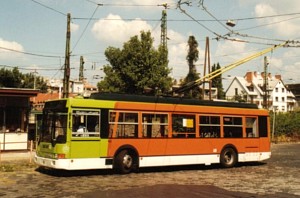 W. Pedro
|
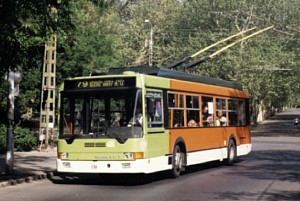 |
|
|
|
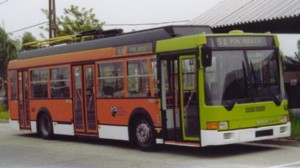 Zoltán Izsó
|
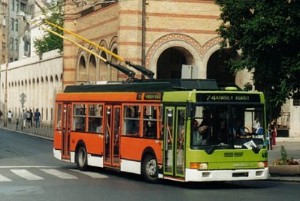 Dániel Szigeti
|
|
|
|
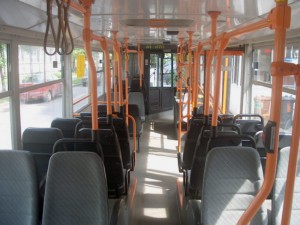 |
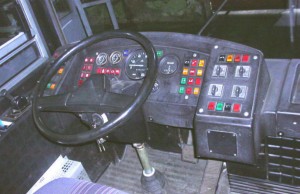 |
|
|
|
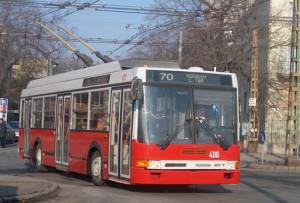 |
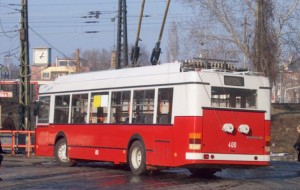 |
|
|
|
Ganz-Ansaldo and Ikarus produced a new trolleybus in the end of the '90s: the capitol of Estonia, Tallin ordered five new low-floor trolleybuses. There trolleybuses were 1 meter longer than the prototypes, hence is the change of type to IK-412T (412.81 series). The five trolleybuses were delivered on the summer of 1999, where they obtained numbers 310-314. At the time, all of them are in service.The IK-412T trolleybuses in Tallin
Technical data:
Its electronical equippment were similar to the IK-280T GVMs: they had DC motors. The difference were the replacment of old thyristors with newer IGBT based choppers, and its new microprocessor based control.
length: 12000 mm self-weight: 11300 kg width: 2500 mm motor: TK 90 LS height: 3400 mm nominal output: 180 kW passanger capacity (seats/standing): 31/67 electronical system: IGBT based DC chopper
Around the millenium, the refreshment of the trolleybus park in Budapest was impossible to postpone, as the face-lifts of the ZIU-9 trolleybuses were impossible to continue economically, and some vehicles were already in apalling situation. In 2000, it was seriously considered to replace some trolleybus routes with autobuses, but after the general objection from the people and the coworkers of the trolleybus depot, the BKV withdraw this plan, and decided to buy 15 new trolleybus. The winner of the contest was again IkarusBus-Obus Ltd.-Kiepe, with low-floor trolleybus IK-412T. The trial runs of the first two trolleybuses started on the winter 2002, officially was taken into the fleet of BKV in May 2002. On the same summer the series followed, they obtained numbers 700-714.The IK-412T trolleybuses in Budapest
These trolleybuses were produced in the final hours of the Ikarus company: after the closure of the Székesfehérvár factory, no more trolleybuses were made. As a last attempt car 705 was taken to Debrecen in early spring 2003 as a demonstration by the IkarusBus-Irisbus. Here it was running for a month with number 802, but the series was neither continued in Debrecen.
Technical data:
The demonstration in Debrecen gave an excellent opportunity to compare the parameters of different low-floor vehicles, as there was also a Skoda 21Tr and a Solaris 12T on a trial. As the disadvantage of the IK-412T one found the tight interior, the boxes covering the wheels take quite big space, and the double seats with 2.5 meters width give alltogether quite narrow floor in the middle. The low ceiling does not help either on the uncomfortable feeling.
length: 12000 mm self-weight: 11900 kg width: 2500 mm motor: SKODA 10ML3550K / 4 axle distance: 6230 mm nominal output: 172 kW passanger capacity (seats/standing): 27/43 electrical system: IGBT based three-phase asinchronous
The advantage of the construction is its advanced electronic outfit. This is the further development of Kiepe's AC equippment, with IGBT based inverter. All these units were put on the roof. The AC motor was this time produced by Skoda, which is driven by 400V stabilized voltage. Not just the running properties of the vehicle became better comparing to the IK-435T, but very low, 0.9-1 kWh/km energy consumption was reached with recuperation. The noise emmision of the electronics is also considerably lower. Similarly to other three-phase trolleybuses, this vehicle cannot roll, either it slightly accelerates or decelerates. However - unlike on Ik-435T - the driver almost cannot notice this feature on the IK-412T. The acceleration of the car can be regulated very finely, and after reaching 50 km/h the car automatically deregulates the acceleration. The electric brake is very smooth and strong also, in most of the cases only at the end of the deceleration one needs to use the pneumatic brake. The suspension of the car is good, one can go with it fast without the fear of dewiring even on uneven roads.
As the electric equippment was enduring quite well the everyday useage
in summer an winter, there were troubles with the less good quality Ikarus
parts. A recurring problem came forward with the malfunction of the doors,
as the trolleybus was designed to be blocked when the doors are open. However,
despite the large axle distance, it is easy to manouvre the car, thanks
to its soft steering wheel. It has an auxilliary servo pump for low speed,
but at high speed the pump is driven from the motor-axle. Due to the low-floor,
it is more difficult to steer the trolleybus near a pavement, without the
fear of hitting the frontal part to the ground. One has to watch the mirror
too, it can hit the heads of the passangers. At the middle of the car there
is a hand operated ramp for disabled passangers.